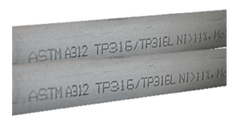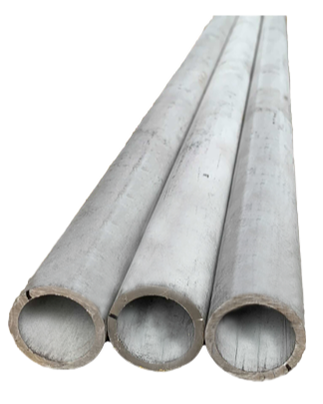|
|
|
Material Specification |
|
Dimension Specification |
|
Outer Diameter Size |
|
Finishing |
|
Stainless steel pipes are manufactured per ASTM A312 TP316/316L standards. SS316/ 316L are the dual grades available for the stainless steel pipes. These grades also allow the dual usage of tubes. The standard length for the material is 6 meters long, and they are known for their unique qualities achieved by incorporating market demands in the production process.
SS316 stainless steel, also known as Marine-grade stainless steel, has high corrosion resistance. Some of the common types of SS316 stainless steel are L, F, H, and N variants. These variants have slight differences from the source and are also used for different purposes. For example, the 316L variant means the steel has a lesser carbon quantity than 316, which has more carbon content.
SS316 stainless steel, also known as Marine-grade stainless steel, has high corrosion resistance. Some of the common types of SS316 stainless steel are L, F, H, and N variants. These variants have slight differences from the source and are also used for different purposes. For example, the 316L variant means the steel has a lesser carbon quantity than 316, which has more carbon content.
1. What is the difference between SS316 and SS316L?
|
Stainless steel is a multi-faceted material made of a steel alloy and little amount of chromium. Chromium is added to the material to increase its corrosion resistance. Stainless steel requires low maintenance, doesn’t destroy other materials when combined, and has the resistance for oxide.
Stainless steel pipes are produced from the stainless steel alloy and used in diverse applications. The SS316/316L stainless steel shares some common traits yet differ in some aspects. The table below will include percentages of elements combined to produces these two variants: |
|
Also, the physical properties of these steel types are listed below:
Both SS316/SS316L sheets of steel have a high anti-corrosion level. Stainless steel is known to be corrosion resistant, however, the addition of chromium also increases the anti-rust level. Also, both steel types exhibit strength at elevated temperatures. This quality contributes to the wide usage of the material, especially for heating appliances. Lastly, both steel types pass through annealing treatment and have flexibility when drawn or bent. |
One significant difference between these two stainless steel types is the carbon content. As stated earlier, the SS316L is a variant of the 316 types. The L added after the figure stands for “low” carbon content. Nickel and Molybdenum are the primary chemical elements in SS316.
On the price, both are similar, however, they are very durable and best fit for high-stress applications. Generally, 316L is a better choice for a project requiring welding parts together. This is because 316 is susceptible to weld decay, however, it can be boosted by annealing treatment.
On the price, both are similar, however, they are very durable and best fit for high-stress applications. Generally, 316L is a better choice for a project requiring welding parts together. This is because 316 is susceptible to weld decay, however, it can be boosted by annealing treatment.
2. What is Stainless Steel Pipe used for?
The versatility of stainless steel pipes has made them commonly used in many industries and companies. Also, they are produced in different sizes and types to fit the individual needs of each industry. Sourcing for a company that doesn’t make use of stainless steel pipes may be a herculean task. Here’s a brief explanation on some of the several uses of stainless steel pipes:
Construction:
In recent times, the construction sector has recorded more use of stainless steel pipes than before. Stainless steel is corrosion-resistant, durable, and cost-effective. This anti-rust property places steel over other metals like iron, as it can be freely used with other elements without any problem. Steel pipes are used to construct ships and serve as good support for heavy buildings situated in areas with weak sand.
Medical Service:
One of the types of stainless steel pipes is Sanitary Pipes. These are carefully formulated to ensure the safety of humans' health and well-being when using stainless steel materials. For cases where the material would come in contact with food or any edible substance, it has properties that ease the cleaning process after usage. Steel pipes are used in the production of surgical tools, pharmaceutical products, dental appliances, etc.
Domestic Use:
Steel pipes are mostly used in a residential apartment because of its high durability. This allows homeowners to save for other needs as the fittings can last for a long period without any worry. Sometimes, a plumber often recommends the material when fixing water connection channels such as showers, taps, etc. Stainless steel materials are used for kitchen utensils and many more.
Factories:
The use of stainless steel pipes also extends to the factories. Many factory machines have some parts made from stainless steel. Also, to ensure the quality of the production process and finished product, stainless steel pipes are used in assembly lines, water treatment systems, etc.
Construction:
In recent times, the construction sector has recorded more use of stainless steel pipes than before. Stainless steel is corrosion-resistant, durable, and cost-effective. This anti-rust property places steel over other metals like iron, as it can be freely used with other elements without any problem. Steel pipes are used to construct ships and serve as good support for heavy buildings situated in areas with weak sand.
Medical Service:
One of the types of stainless steel pipes is Sanitary Pipes. These are carefully formulated to ensure the safety of humans' health and well-being when using stainless steel materials. For cases where the material would come in contact with food or any edible substance, it has properties that ease the cleaning process after usage. Steel pipes are used in the production of surgical tools, pharmaceutical products, dental appliances, etc.
Domestic Use:
Steel pipes are mostly used in a residential apartment because of its high durability. This allows homeowners to save for other needs as the fittings can last for a long period without any worry. Sometimes, a plumber often recommends the material when fixing water connection channels such as showers, taps, etc. Stainless steel materials are used for kitchen utensils and many more.
Factories:
The use of stainless steel pipes also extends to the factories. Many factory machines have some parts made from stainless steel. Also, to ensure the quality of the production process and finished product, stainless steel pipes are used in assembly lines, water treatment systems, etc.
3. What are main advantages of Stainless Steel Pipes?
With the numerous uses of stainless steel pipes, the question “Why Stainless Steel Pipes” may pop-up in mind. Here are some of the reasons why stainless steel is mostly preferred and widely used:
|
4. How do you connect Stainless Steel Pipe?
|
The joining process of stainless steel pipes is very simple. Three different installation methods can be used – plain end, bevel end, and threaded end connection. Despite the different installation methods, customization of pipe ends can be done to fit into other materials properly.
The table below shows the features of each installation process: |
Installation Method |
Characteristics |
Threaded End |
|
Bevel End |
|
Plain End |
|
STAINLESS STEEL PIPES catalogue









